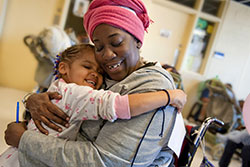CONTACT:
John Chibnall, Powell Communications
212 475 6301 | john@powellny.com
New Report Examines Youth Incarcerated in Adult Jails
New York’s Raise the Age Law Will End the Practice of Placing Sentenced or Detained Adolescents in Adult Facilities
New York, New York August 28, 2018 —
With adult jails housing an increasing number of state prisoners, and the population within juvenile detention facilities shrinking, now is the time to reassess the way youth prosecuted as adults are incarcerated in America. Full implementation of New York’s Raise the Age Law ends the practice in New York and is recognized as a significant strategy for protecting youth, according to a new report from UCLA School of Law.
“Getting to Zero: A 50 State Study of Strategies to Remove Youth from Adult Jails,” analyzes national data sets and state laws to provide concrete policy change recommendations to remove youth from adult jails across the country.
“Our children do not belong in adult facilities. Youth face heightened risk of physical and sexual abuse, as well as mental health crisis, including suicide, when housed with adults. The Campaign is proud to have New York’s law part of the Getting to Zero report, and to contribute to the nation-wide effort to remove all adolescents from adult jails and prisons.” Naomi Post, Executive Director of Children’s Defense Fund-New York.
“New York is on the precipice of ensuring no youth will ever be placed in an adult jail or prison again. On October 1st, this practice will finally end and in New York City all youth will be removed from adult jails. This is an historic victory for New York’s youth, and their families and communities, and I am so relieved it is finally coming to fruition,” said Jennifer March, Executive Director of Citizens’ Committee for Children.
“Behind the chilling statistics cited in this report are young people who experienced unimaginable suffering within the walls of an adult jail as well as families who suffered from outside them. As parents, we have witnessed first-hand the detrimental impact that adult jails have had on our youth. Through these experiences, we know that the pathway to productive citizenship is through appropriate services, engagement and supports. We applaud the authors for building a compelling case for why “Getting to Zero” is so important and offering a road map for how we get there.” Paige Pierce, Chief Executive Officer, Families Together in New York State.
“Trauma begets trauma and jail begets more jail when it comes to our children housed in adult facilities. Getting to Zero sets forth a realistic agenda of next steps for states across our nation.”
David Condliffe, Executive Director of the Center for Community Alternatives.
An overwhelming amount of research shows that the adult criminal justice system is ill-equipped to meet the needs of youth, from trial to incarceration and re-entry. Beyond what brain science reveals about adolescent development, the adult criminal justice system does not reduce recidivism and often leaves youth at risk of abuse.
• Youth in adult jails are at extreme risk of suicide. Every year since 2010, an average of three children have died in adult jails; two out of three by suicide. Youth under the age of 17 in adult jails have a mortality rate nearly twice that of young adults (18-24-year-olds) in adult jails, 9 times higher than youth in the general population, and 36 times more likely to commit suicide in an adult jail than in juvenile detention facility.
• Youth in adult jails are at extreme risk of sexual abuse by jail staff and other inmates, even during brief detention stays: 15% of sexual abuse victims in jails report having been abused by another inmate within the first 24 hours of their arrival at the jail. In fact, sexual abuse by staff in jails is the highest for the youngest inmates (3.3%). Some populations of youth are particularly vulnerable – girls have higher rates of sexual abuse compared to boys (4.4% compared to 1.6%); white youth have higher rates of abuse than black and Latino youth (6.6% versus 1.1%); and youth who are sexual minorities (e.g., LGBT youth) have higher rates of abuse than heterosexual youth (6.3% versus 1.7%).
Although the number of youth in adult jails has declined over 50 percent since a recent peak in 2010, between 32,000 and 60,000 youth are estimated to enter adult jails every year.
Getting to Zero provides the first-ever analysis of three nationwide datasets – the Bureau of Justice Statistics’ (BJS) Census of Jails and Annual Survey of Jails, and the Office of Juvenile Justice and Delinquency Prevention’s Census of Juvenile Residential Placements – to examine how youth currently housed in adult jails can be safely housed in juvenile facilities. Second, it summarizes the major legal developments applicable to youth housed in adult jails. Third, it provides specific examples from jurisdictions across the country which have made substantial progress toward removing youth from adult jails, including New York.
Neelum Arya, study author explains, “For the first time we have data to show exactly where youth are incarcerated in adult jails in America, the legal analysis to explain why it happens, and examples of what policymakers can do to remove youth from jails altogether.”
Key Facts from New York
• According to the report, there were 735 youth held in adult jails in New York on the day the Census of Jails was taken in 2013. There were 72 jails which participated in the 2013 Census of Jails. Fifty (69%) of the jails in the state were housing youth on the day the Census was taken. Twenty-nine jails were holding 5 or more youth on the day the Census was taken; 21 jails housing youth were holding 4 or less youth on the day the Census was taken.
• With full implementation of Raise the Age in New York, no 16 or 17 year old will be sentenced to or detained in a facility with adults. On October 1, 2018, 16 year olds whose cases are heard in Family Court will be detained or placed in juvenile facilities, followed by 17 year olds on October 1, 2019. These include facilities operated or licensed by the New York State Office of Children and Family Services (OCFS), or the City’s Administration for Children’s Services, just as Juvenile Delinquents are. On October 1, 2018, 16 year olds whose cases are heard in the new Youth Part of the adult Criminal Court will be held in specialized secure detention facilities certified and regulated by OCFS in conjunction with the State Commission of Correction, followed by 17 year olds on October 1, 2019. Youth whose cases are heard in the Youth Part and are sentenced to state imprisonment will be placed in a secure juvenile facility developed by the state with security managed by New York State Department of Corrections and Community Supervision, with the assistance of OCFS. As of October 1, 2018, no youth under the age of 18 can be held at New York City’s Rikers Island.
Getting to Zero also provides an overview of positive changes that have taken place and identifies specific strategies states can use to remove youth from adult jails. Since 2009, 20 States and the District of Columbia have passed laws which have started to limit the admissions to, or remove youth from, adult jails.
The report provides recommendations for policymakers at the federal, state, and local level; jailors and juvenile detention administrators; prosecutors and public defenders; and advocates all have a role to play to assist in Getting to Zero.
• The single most significant strategy in the effort to remove youth from adult jails is “Raise the Age” legislation. More than half (54%) of the youth incarcerated in adult jails can be removed as part of the implementation of this legislation in nine states. Louisiana, New York, North Carolina, Missouri, and South Carolina are in the process of implementation. Georgia, Michigan, Texas, and Wisconsin still need to pass this type of law.
• The second most important strategy in the effort to remove youth from adult jails are efforts to change the state transfer law through modifying statutory exclusion laws which automatically exclude a youth from the juvenile justice system. If six states – Alabama, Arizona, Florida, Oklahoma, Maryland, and Pennsylvania – were to change their transfer laws and jail laws to prohibit youth from being held in adult jails at arrest, the population of youth in adult jails could be reduced by an additional 26%.
• Every State which currently allows youth to be housed in adult jails should consider updating their jail law to ensure youth are only housed in adult jails in the rarest of instances. There are several states – notably Arizona, Florida, Maryland, Oklahoma, and Wisconsin – where the text of the state jail law requires that youth must be held in an adult jail under certain circumstances. If these 5 states were to change course and go from requiring to prohibiting housing youth in adult jails, the number of youth incarcerated in adult jails would drop by 21%.
• In addition to state-level reforms, city and county officials should pass specific ordinances and develop internal county policies to include presumptions that youth tried as adults are detained in juvenile facilities. Although large urban jails holding large numbers of youth dominate the conversations about youth in adult jails, most counties and jails hold few youth at a time which the report shows could be accommodated in other juvenile facilities. If counties which held less than 9 youth at a time found other placements for these youth, the number of youth incarcerated in adult jails would drop by 33%.
For additional information about the Getting to Zero report, please visit: www.GettingToZero.us
The Raise the Age NY Campaign includes over one hundred diverse organizations from across New York State, including formerly incarcerated youth and their families, child advocates, service providers, faith leaders, legal services groups, and unions. Our work draws both on the lessons learned in 48 other states and the wealth of scientific research on adolescent and brain development.
For additional information about Raise the Age NY, visit: http://raisetheageny.com/about-us
###


